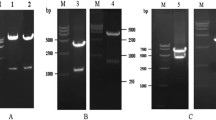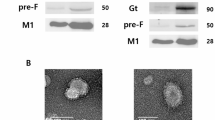Abstract
Infections with influenza and respiratory syncytial virus (RSV) rank high among the most common human respiratory diseases worldwide. Previously, we developed a replication-incompetent influenza virus by replacing the coding sequence of the PB2 gene, which encodes one of the viral RNA polymerase subunits, with that of a reporter gene. Here, we generated a PB2-knockout recombinant influenza virus expressing the F protein of RSV (PB2-RSVF virus) and tested its potential as a bivalent vaccine. In mice intranasally immunized with the PB2-RSVF virus, we detected high levels of antibodies against influenza virus, but not RSV. PB2-RSVF virus-immunized mice were protected from a lethal challenge with influenza virus but experienced severe body weight loss when challenged with RSV, indicating that PB2-RSVF vaccination enhanced RSV-associated disease. These results highlight one of the difficulties of developing an effective bivalent vaccine against influenza virus and RSV infections.






Similar content being viewed by others
References
World Health Organization (2009) Acute respiratory infections (update September 2009). http://www.who.int/vaccine_research/diseases/ari/en/index2.html
Girard MP, Cherian T, Pervikov Y, Kieny MP (2005) A review of vaccine research and development: human acute respiratory infections. Vaccine 23:5708–5724
Kim HW, Canchola JG, Brandt CD, Pyles G, Chanock RM et al (1969) Respiratory syncytial virus disease in infants despite prior administration of antigenic inactivated vaccine. Am J Epidemiol 89:422–434
Haynes LM, Jones LP, Barskey A, Anderson LJ, Tripp RA (2003) Enhanced disease and pulmonary eosinophilia associated with formalin-inactivated respiratory syncytial virus vaccination are linked to G glycoprotein CX3C–CX3CR1 interaction and expression of substance P. J Virol 77:9831–9844
Delgado MF, Coviello S, Monsalvo AC, Melendi GA, Hernandez JZ et al (2009) Lack of antibody affinity maturation due to poor Toll-like receptor stimulation leads to enhanced respiratory syncytial virus disease. Nat Med 15:34–41
Chang J (2011) Current progress on development of respiratory syncytial virus vaccine. BMB Rep 44:232–237
Shao HY, Yu SL, Sia C, Chen Y, Chitra E et al (2009) Immunogenic properties of RSV-B1 fusion (F) protein gene-encoding recombinant adenoviruses. Vaccine 27:5460–5471
Singh SR, Dennis VA, Carter CL, Pillai SR, Jefferson A et al (2007) Immunogenicity and efficacy of recombinant RSV-F vaccine in a mouse model. Vaccine 25:6211–6223
Olmsted RA, Elango N, Prince GA, Murphy BR, Johnson PR et al (1986) Expression of the F glycoprotein of respiratory syncytial virus by a recombinant vaccinia virus: comparison of the individual contributions of the F and G glycoproteins to host immunity. Proc Natl Acad Sci USA 83:7462–7466
Bembridge GP, Lopez JA, Bustos R, Melero JA, Cook R et al (1999) Priming with a secreted form of the fusion protein of respiratory syncytial virus (RSV) promotes interleukin-4 (IL-4) and IL-5 production but not pulmonary eosinophilia following RSV challenge. J Virol 73:10086–10094
Bembridge GP, Lopez JA, Cook R, Melero JA, Taylor G (1998) Recombinant vaccinia virus coexpressing the F protein of respiratory syncytial virus (RSV) and interleukin-4 (IL-4) does not inhibit the development of RSV-specific memory cytotoxic T lymphocytes, whereas priming is diminished in the presence of high levels of IL-2 or gamma interferon. J Virol 72:4080–4087
Bembridge GP, Rodriguez N, Garcia-Beato R, Nicolson C, Melero JA et al (2000) DNA encoding the attachment (G) or fusion (F) protein of respiratory syncytial virus induces protection in the absence of pulmonary inflammation. J Gen Virol 81:2519–2523
Grimaldi M, Gouyon B, Sagot P, Quantin C, Huet F et al (2007) Palivizumab efficacy in preterm infants with gestational age < or = 30 weeks without bronchopulmonary dysplasia. Pediatr Pulmonol 42:189–192
(1998) Palivizumab, a humanized respiratory syncytial virus monoclonal antibody, reduces hospitalization from respiratory syncytial virus infection in high-risk infants. The IMpact-RSV Study Group. Pediatrics 102:531–537
Brock SC, Heck JM, McGraw PA, Crowe JE Jr (2005) The transmembrane domain of the respiratory syncytial virus F protein is an orientation-independent apical plasma membrane sorting sequence. J Virol 79:12528–12535
Bembridge GP, Rodriguez N, Garcia-Beato R, Nicolson C, Melero JA et al (2000) Respiratory syncytial virus infection of gene gun vaccinated mice induces Th2-driven pulmonary eosinophilia even in the absence of sensitisation to the fusion (F) or attachment (G) protein. Vaccine 19:1038–1046
Wright PF, Neumann G, Kawaoka Y (2007) Othomyxoviruses. In: Howley DMKPM (ed) Fields virology, 5th edn. Lippincott Williams & Wilkins, Philadelphia, pp 1691–1740
Ozawa M, Kawaoka Y (2011) Taming influenza viruses. Virus Resh 162:8–11
Neumann G, Watanabe T, Ito H, Watanabe S, Goto H et al (1999) Generation of influenza A viruses entirely from cloned cDNAs. Proc Natl Acad Sci USA 96:9345–9350
Ozawa M, Victor ST, Taft AS, Yamada S, Li C et al (2011) Replication-incompetent influenza A viruses that stably express a foreign gene. J Gen Virol 92:2879–2888
Victor ST, Watanabe S, Katsura H, Ozawa M, Kawaoka Y (2012) A replication-incompetent PB2-knockout influenza A virus vaccine vector. J Virol 86:4123–4128
Uraki R, Kiso M, Iwatsuki-Horimoto K, Fukuyama S, Takashita E et al (2013) A novel bivalent vaccine based on a PB2-knockout influenza virus protects mice from pandemic H1N1 and highly pathogenic H5N1 virus challenges. J Virol 87:7874–7881
DuBridge RB, Tang P, Hsia HC, Leong PM, Miller JH et al (1987) Analysis of mutation in human cells by using an Epstein–Barr virus shuttle system. Mol Cell Biol 7:379–387
Hatakeyama S, Sakai-Tagawa Y, Kiso M, Goto H, Kawakami C et al (2005) Enhanced expression of an alpha2,6-linked sialic acid on MDCK cells improves isolation of human influenza viruses and evaluation of their sensitivity to a neuraminidase inhibitor. J Clin Microbiol 43:4139–4146
Niwa H, Yamamura K, Miyazaki J (1991) Efficient selection for high-expression transfectants with a novel eukaryotic vector. Gene 108:193–199
Horimoto T, Murakami S, Muramoto Y, Yamada S, Fujii K et al (2007) Enhanced growth of seed viruses for H5N1 influenza vaccines. Virology 366:23–27
Xie C, He JS, Zhang M, Xue SL, Wu Q et al (2007) Oral respiratory syncytial virus (RSV) DNA vaccine expressing RSV F protein delivered by attenuated Salmonella typhimurium. Hum Gene Ther 18:746–752
Moghaddam A, Olszewska W, Wang B, Tregoning JS, Helson R et al (2006) A potential molecular mechanism for hypersensitivity caused by formalin-inactivated vaccines. Nat Med 12:905–907
Kohlmann R, Schwannecke S, Tippler B, Ternette N, Temchura VV et al (2009) Protective efficacy and immunogenicity of an adenoviral vector vaccine encoding the codon-optimized F protein of respiratory syncytial virus. J Virol 83:12601–12610
Kida H, Brown LE, Webster RG (1982) Biological activity of monoclonal antibodies to operationally defined antigenic regions on the hemagglutinin molecule of A/Seal/Massachusetts/1/80 (H7N7) influenza virus. Virology 122:38–47
Openshaw PJ, Clarke SL, Record FM (1992) Pulmonary eosinophilic response to respiratory syncytial virus infection in mice sensitized to the major surface glycoprotein G. Int Immunol 4:493–500
Olszewska W, Suezer Y, Sutter G, Openshaw PJ (2004) Protective and disease-enhancing immune responses induced by recombinant modified vaccinia Ankara (MVA) expressing respiratory syncytial virus proteins. Vaccine 23:215–221
Haynes LM, Moore DD, Kurt-Jones EA, Finberg RW, Anderson LJ et al (2001) Involvement of toll-like receptor 4 in innate immunity to respiratory syncytial virus. J Virol 75:10730–10737
Kurt-Jones EA, Popova L, Kwinn L, Haynes LM, Jones LP et al (2000) Pattern recognition receptors TLR4 and CD14 mediate response to respiratory syncytial virus. Nat Immunol 1:398–401
Boelen A, Andeweg A, Kwakkel J, Lokhorst W, Bestebroer T et al (2000) Both immunisation with a formalin-inactivated respiratory syncytial virus (RSV) vaccine and a mock antigen vaccine induce severe lung pathology and a Th2 cytokine profile in RSV-challenged mice. Vaccine 19:982–991
Schwarze J, Hamelmann E, Bradley KL, Takeda K, Gelfand EW (1997) Respiratory syncytial virus infection results in airway hyperresponsiveness and enhanced airway sensitization to allergen. J Clin Invest 100:226–233
Barends M, Van Oosten M, De Rond CG, Dormans JA, Osterhaus AD et al (2004) Timing of infection and prior immunization with respiratory syncytial virus (RSV) in RSV-enhanced allergic inflammation. J Infect Dis 189:1866–1872
Becker Y (2006) Respiratory syncytial virus (RSV) evades the human adaptive immune system by skewing the Th1/Th2 cytokine balance toward increased levels of Th2 cytokines and IgE, markers of allergy–a review. Virus Genes 33:235–252
Rosenberg HF, Dyer KD, Domachowske JB (2009) Respiratory viruses and eosinophils: exploring the connections. Antiviral Res 83:1–9
Stevens WW, Sun J, Castillo JP, Braciale TJ (2009) Pulmonary eosinophilia is attenuated by early responding CD8(+) memory T cells in a murine model of RSV vaccine-enhanced disease. Viral Immunol 22:243–251
Prince GA, Jenson AB, Hemming VG, Murphy BR, Walsh EE et al (1986) Enhancement of respiratory syncytial virus pulmonary pathology in cotton rats by prior intramuscular inoculation of formalin-inactivated virus. J Virol 57:721–728
Acknowledgments
We thank Abigail Betanzos for her assistance during the project, and Susan Watson for editing the manuscript. This study was supported by a grant from the National Institute of Allergy and Infectious Disease, by a Grant-in-Aid for Specially Promoted Research, by a contract research fund for the Program of Founding Research Centers for Emerging and Reemerging Infectious Diseases from the Ministry of Education, Culture, Sports, Science, and Technology, by grants-in-aid from the Ministry of Health, by ERATO (Japan Science and Technology Agency), and by the Advanced Research for Medical Products Mining Programme of the National Institute of Biomedical Innovation (NIBIO). This work was, in part, also funded by the Institute of Science and Technology of Federal District Icyt-DF (project number, ICyT-DF23/2011). W.F. received financial support from the National Council on Science and Technology of Mexico (Conacyt-Mexico) and from the Fulbright-García Robles program.
Author information
Authors and Affiliations
Corresponding authors
Rights and permissions
About this article
Cite this article
Fonseca, W., Ozawa, M., Hatta, M. et al. A recombinant influenza virus vaccine expressing the F protein of respiratory syncytial virus. Arch Virol 159, 1067–1077 (2014). https://doi.org/10.1007/s00705-013-1932-z
Received:
Accepted:
Published:
Issue Date:
DOI: https://doi.org/10.1007/s00705-013-1932-z




